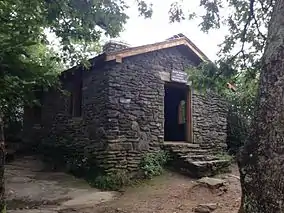Blood Mountain Wilderness
The Blood Mountain Wilderness was designated in 1991 and currently consists of 7,800 acres (32 km2). The Wilderness is located within the borders of the Chattahoochee National Forest in Lumpkin County and Union County, Georgia. The Wilderness is managed by the United States Forest Service and is part of the National Wilderness Preservation System. In November, 1999, three fires burned through parts of the Blood Mountain Wilderness and the Chatahoochee National Forest. Fire crews came from across the nation to help fight the fires.
| Blood Mountain Wilderness | |
|---|---|
IUCN category Ib (wilderness area) | |
 The historic Blood Mountain Trail Shelter is in the Wilderness Area. | |
 Map of the United States | |
| Location | Lumpkin / Union counties, Georgia, USA |
| Nearest city | Blairsville, Georgia |
| Coordinates | 34°44′38″N 83°56′21″W |
| Area | 7,800 acres (32 km2) |
| Established | 1991 |
| Governing body | United States Forest Service |
The highest elevation in the Blood Mountain Wilderness is the 4,458-foot (1,359 m) peak of Blood Mountain. The Wilderness includes 10.75 miles (17.30 km) of the Appalachian Trail, which may be the most heavily used portion of the AT. The Blood Mountain Wilderness is the first wilderness encountered on the AT after its starting point on Springer Mountain.
Due to conflicts with black bears, in 2012 the Forest Service implemented a seasonal requirement for all overnight campers to carry bear-resistant canisters. The requirement goes into effect every year, from March 1 to June 1, and it encompasses all areas within quarter mile of the AT, from Jarrard Gap to Neels Gap.[1]
In connection with its management of the Wilderness, the Forest Service actively promotes adherence to the Leave No Trace principles. The seven Leave No Trace principles are:
- Plan Ahead and Prepare
- Travel and Camp on Durable Surfaces
- Dispose of Waste Properly
- Leave What You Find
- Minimize Campfire Impacts
- Respect Wildlife
- Be Considerate of Other Visitors
See also
References
- Toppins, Judy (16 January 2013). "Appalachian Trail Hikers and Forest Service Manage Bear Conflicts Through Use of Bear-Resistant Storage Canisters". www.fs.usda.gov/. United States Forest Service. Retrieved 2 September 2015.
External links
- Wilderness.net entry for the Blood Mountain Wilderness
- Blood Mountain Wilderness
- Photos from after the 1999 fire {Please Scroll down after opening}
- Leave No Trace organization